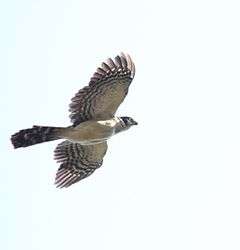Collared forest falcon
| Collared forest falcon | |
|---|---|
 | |
| Scientific classification | |
| Kingdom: | Animalia |
| Phylum: | Chordata |
| Class: | Aves |
| Order: | Falconiformes |
| Family: | Falconidae |
| Genus: | Micrastur |
| Species: | M. semitorquatus |
| Subspecies: | M. semitorquatus semitorquatus
M. semitorquatus naso |
| Binomial name | |
| Micrastur semitorquatus (Vieillot, 1817) | |
The collared forest falcon (Micrastur semitorquatus) is a species of bird of prey in the Falconidae family. It is the biggest member of the Micrastur genus and a common inhabitant of tropical rainforests in South America.
Description
The collared forest falcon has a dark coloured back with a white neck and breast. The species has three morphological variants (morphs): pale, tawny and dark. The former two have a light coloured collar at the back of their neck, which explains their name. Although its forest lifestyle, rounded, relatively short wings, long tail and lack of the characteristic beak tooth suggest affinities to hawks, there are several morphological connections to the Falconidae in which it is now placed, e.g. moult pattern and the morphology of the skull.[2]
Distribution and habitat
The species can be found in many South American countries: Argentina, Belize, Bolivia, Brazil, Colombia, Costa Rica, Ecuador, El Salvador, French Guiana, Guatemala, Guyana, Honduras, Mexico, Nicaragua, Panama, Paraguay, Peru, Suriname and Venezuela, where it is frequently common. Its natural habitats are subtropical or tropical dry forests and subtropical or tropical moist lowland forests. Unlike most other falcons they avoid open areas, as their body is adapted to flying in forests.[3]
The species is extremely widespread, with a total estimated population between 500,000 and 5 million individuals.[1]
Behaviour
The collared forest falcon mainly feeds on small mammals and birds but also takes lizards and snakes. They are believed to locate their prey by hearing, but with their relatively big eyes they can also see in the low light conditions associated with thick forest. They often spend time on the ground, preferring to walk than fly in open areas and sometimes they even run down their prey.[4]
References
- 1 2 BirdLife International (2012). "Micrastur semitorquatus". IUCN Red List of Threatened Species. Version 2013.2. International Union for Conservation of Nature. Retrieved 26 November 2013.
- ↑ Mauersberger, Gottfried (1978). Urania Állatvilág. Budapest: Gondolat Kiadó. p. 135.
- ↑ "Collared forest falcon - Micrastur semitorquatus". BirdLife International (2016) Species factsheet.
- ↑ . 2010. Collared Forest-Falcon (Micrastur semitorquatus), Neotropical Birds Online (T. S. Schulenberg (ed.). Ithaca: Cornell Lab of Ornithology http://neotropical.birds.cornell.edu/portal/species/overview?p_p_spp=22502. Missing or empty
|title=(help)
